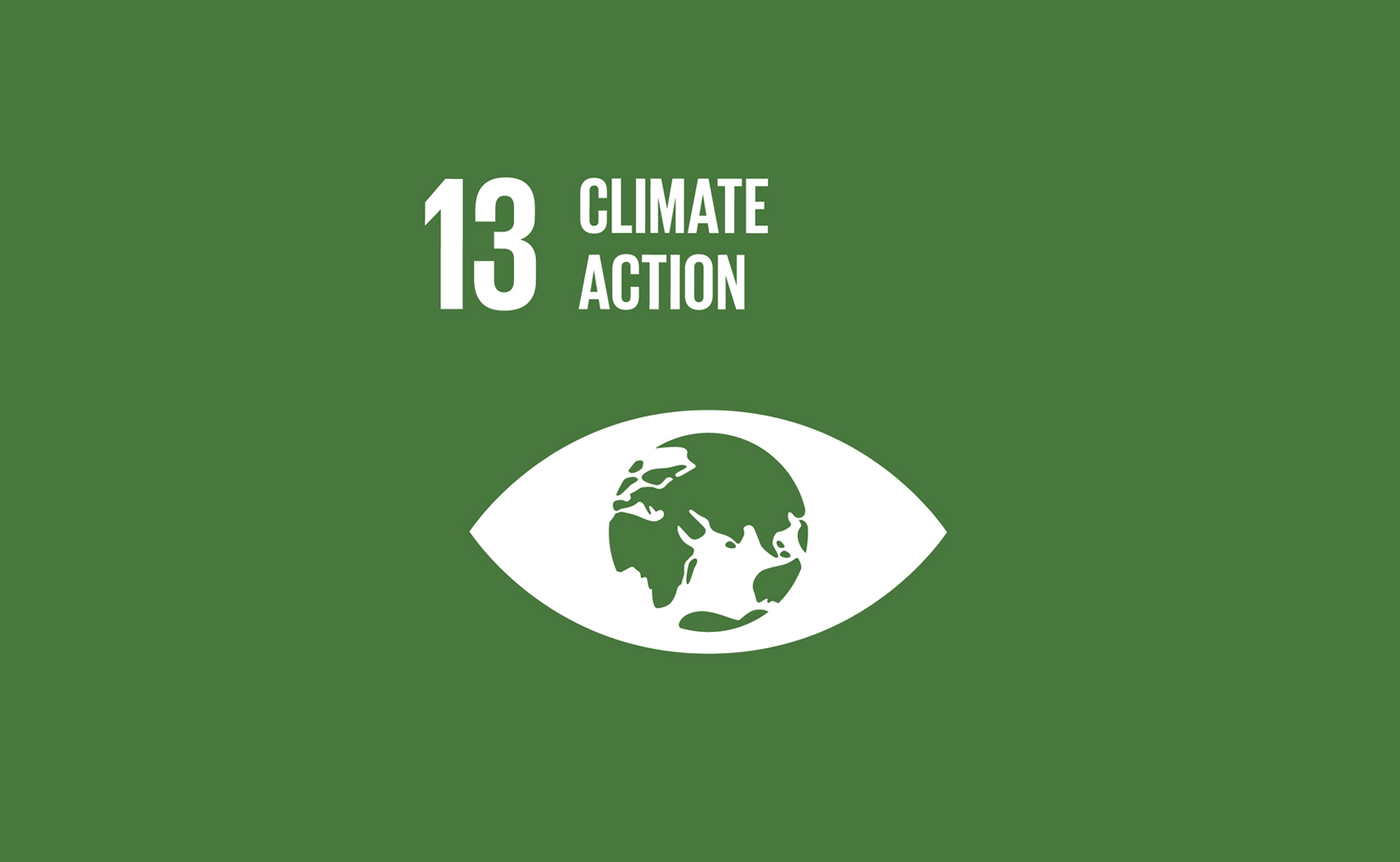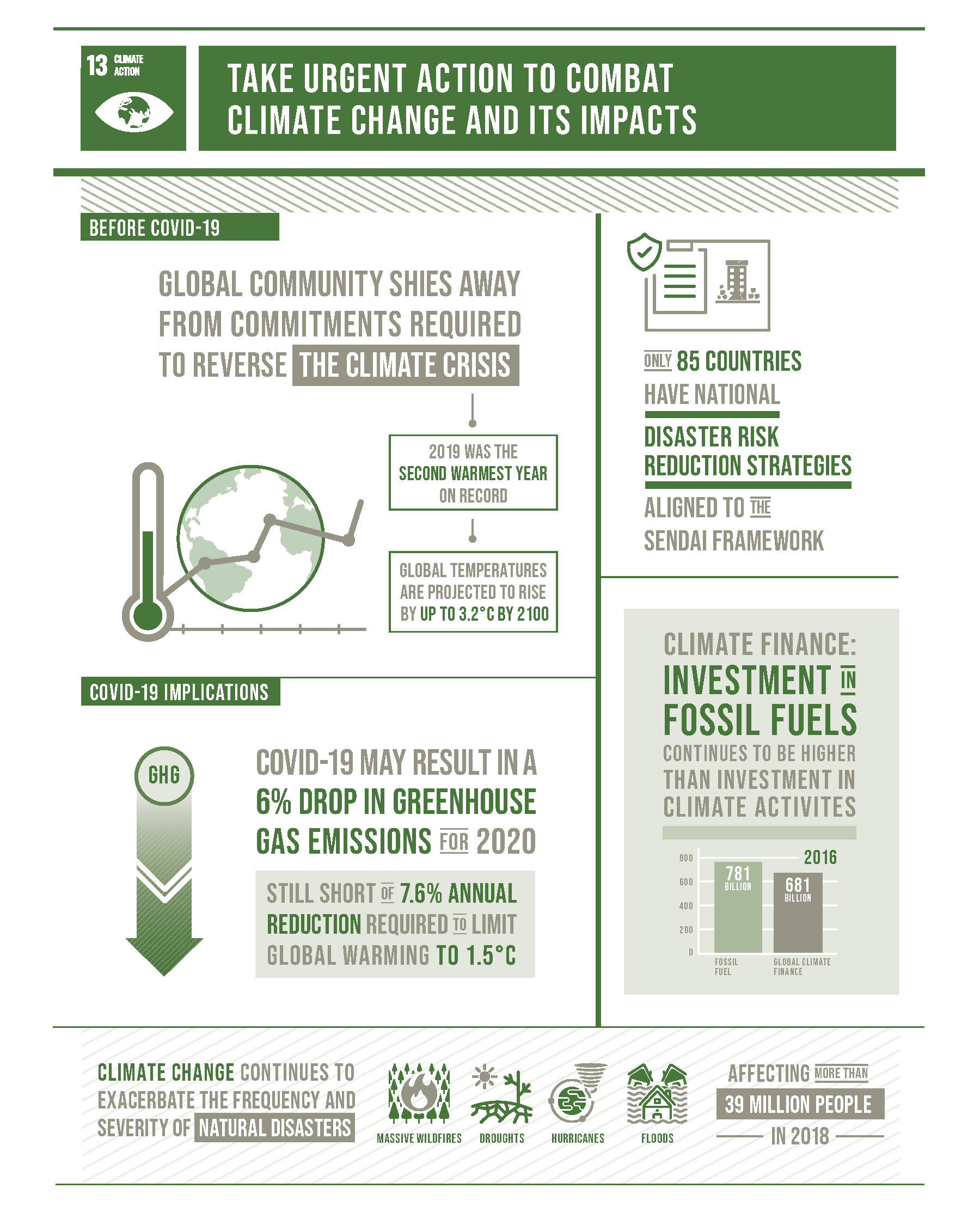Taking urgent action to combat climate change and its impacts is the thirteenth goal of the 2030 Agenda for Sustainable Development

⠀⠀⠀⠀⠀⠀⠀⠀
There is no country or city that has not felt yet the effects of global warming. This is because the consequences of such devastation are already visible: in addition to the increasing rise of our planet’s temperature and the ocean, we are dealing with rising sea levels, melting ice and all the direct impacts generated on ecosystems, food production and human health.
Pollution, greenhouse gas emissions and unrestrained consumption are some of the reasons that lead the planet to increase its average temperature every year, to a point that has become unsustainable. The year of 2019 was the second warmeston record in the entire history of the planet (the first place is still occupied by 2016), and greenhouse gas emissions are already 50% higher than in 1990.
The need for changes in the way we consume and produce led countries around the world to come together in 2015 and sign the Paris Agreement. The objective is to strengthen policies that reduce damage and climate change through investments and new technologies, capable of creating alternative energy sources and cleaner economic models. The main goal is very clear: to keep the planet’s temperature rise below 2 ºC for this century.
What seems simple, however, has become an unachievable challenge. According to the UN, several temperature records have already been broken in recent years: in addition to the 2010-2019 decade being the hottest one on record, analyzes show that even with the Paris Agreement, we are only increasing the average temperature on Earth.
Fghting global warming is so urgent that, in 2015, the UN also included the issue in its global action plan, the 2030 Agenda for Sustainable Development. Among the 17 objectives listed in the document is SDG 13 – Climate Action, whose mission is “to take urgent measures to combat climate change and its impacts“.
And how can we achieve this? Bright Cities believes that clean, sustainable and resilient actions are fundamental not only for the planet, but also for our own cities. In a Smart City, services and public management are combined with innovative technologies and solutions to protect natural resources and ensure that they are always used responsibly. For a smart city, preserving the environment is essential to achieve quality of life.
Therefore, when our platform performs the diagnosis of a city, more than 20 indicators are used to evaluate its environmental performance. In total, we have 160 international indicators that analyze the urban performance in ten areas, such as education, security, governance and mobility, among others. To understand how this information is fundamental for building more sustainable cities, we listed below some of the indicators used by Bright Cities that are directly aligned with SDG 13 – Climate Action:
- Indicators “Concentration of Particulate Matter (PM10)” and “Concentration of Fine Particulate Matter (PM2.5)”: the particulate material can originate in the most different places and processes, as in the burning of fossil fuels, and is related to atmospheric pollution. The data obtained by the indicator, therefore, reveal the air quality and the contribution of a given city to global warming. Mayors and public managers, having these numbers in hand, can better scale their efforts to achieve target 13.2 of SDG 13: “Integrate climate change measures into national policies, strategies and planning“;
- Indicator “Number of deaths due to natural disasters”: floods, storms, lightning and high temperatures are some of the natural disasters present in cities, and reveal how they should prepare for climate change and its consequences. Thus, with the data obtained by the indicator, a municipality can propose actions to achieve target 13.1 of SDG 13: “Strengthen resilience and adaptive capacity to climate-related hazards and natural disasters in all countries“;
- Indicator “Percentage of energy derived from renewable sources”: the burning of fossil fuels is a major cause of global warming. With the data provided by the indicator, public managers can assess how much the municipality needs to invest in renewable and clean sources, as mentioned in target 13.2 of SDG 13: “Integrate climate change measures into national policies, strategies and planning“;
Through the collection and analysis of these indicators, a city is able to adopt safer and more efficient public policies for the population and, of course, for the planet. All these information is collected and gathered by Bright Cities on its online platform, consolidating data from different urban areas in one place. Created in an integrated way, our analysis encourages a dialogue between the most different Municipal Secretariats, such as those of Health, Transport, Education and, of course, Environment.
After all, when we talk about sustainability, we need to go far beyond ecosystems and also address issues like economics, health and education. To get an idea of the influence of environmental policies on the global market, a survey by the United Nations Development Program showed that the average annual economic losses due to climate disasters are hundreds of billions of dollars.
Achieving the SDG 13 means overcoming a number of other planetary problems as well. Starting, for example, with the problem of hunger: if we do not preserve our resources and reduce our climate impacts, agricultural production will suffer inestimable losses and we will be far from reaching the ODS 1- Zero Hunger. The economic impact that this can generate would also prevent us from achieving SDG 8 – Decent work and economic growth. Not to mention the risks that climatic effects would have on people’s health, going against the SDG 3 – Health and Well-Being. According to the UN, geophysical disasters – 91% of the time related to climate – have already killed 1.3 million people and injured 4.4 billion between 1998 and 2017.
These would be just some of the negative impacts generated if the goals of the Paris Agreement and SDG 13 are not accomplished. Countless facts just prove that changes in the way we live are increasingly urgent, but the good news is that we are not short of solutions and technologies that can help us get there.
Free of charge, the Bright Cities platform provides a databse with more than 1,000 solutions for urban challenges – in the environmental area, there are more than 200 solutions!
One of these initiatives is produced by EIXVERD, responsible for the construction of ecological roofs. The solution promotes the adaptation and mitigation of climate change for more resilient cities and, ultimately, a higher quality of urban life. It also seeks to raise citizen awareness and participation for stronger, more coordinated action to address climate change. The goal is naturalizes rooftops of city buildings with green roofs, rooftop farms, aromatic plots and solar panels and design.
Solutions like this, simple and accessible, have become increasingly welcome in a context that borders on environmental collapse. According to worrying data released by the UN:
- If we take no action, the average global temperature should rise by 3 °C by the end of the 21st century. The poorest and most vulnerable people will be the most affected by warming, in addition to a possible extinction of 25-50% of animal species;
- Sea level has risen about 20 cm since 1880 and is expected to increase another 30-122 cm by 2100, devastating coastal cities;
- The ocean absorbs about 30% of anthropogenic carbon dioxide emitted, becoming more acidic and risking the lives of millions of living beings;
- To limit global warming to 1.5 °C, global CO2 emissions should to drop 45% between 2010 and 2030 and reach 0% by 2050;
- Bold climate action can generate at least $ 26 trillion in economic benefits by 2030.

⠀⠀⠀⠀⠀⠀⠀⠀
Although researches shows a drop of up to 6% in global C02 emissions due to the coronavirus pandemic, we know that this improvement is only temporary. As said by the UN, climate change does not stop. The economic, political and health crisis that we are experiencing may be, precisely, an opportunity for a profound change in the way we live, hence the importance of having Smart Cities to guide us in this transformation.
In Brazil, the environmental agenda has taken on great proportions with recent events. With the constant advances in the number of fires, about 29 international investment funds, responsible for managing 4.1 trillion dollars in assets, sent a letter to the Brazilian government showing concern about environmental policies in the country. The market pressure for countries and companies to adopt strict environmental controls and ESG practices is such that investment funds focused on social and environmental issues grew 29% in June, compared to the same period in 2019.
The interest in an environmental agenda reveals that cities with sustainable policies are ahead in terms of benefits and investments. For this to happen, however, action by our representatives is needed. Always working in partnership with mayors and public agencies, Bright Cities is the fastest and most efficient way to generate sustainable transformation in cities. With our personalized diagnosis and roadmaps, we encourage concrete actions towards the goals of the SDGs and intensify the collection and use of data for decision making.
To learn more about our work, check out the special content we have prepared presenting the platform. If you want to know more about Smart Cities and how your city can become one, download our free e-book “How to transform your city into a Smart City” (in portuguese only). Bright Cities is a disruptive platform to diagnose your city itinerary so that it becomes smarter every day. Upgrade your city!



